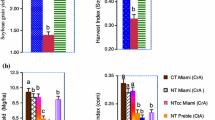Abstract
Frequently soil-plant relationships and responses are complex combinations of increases-level-decreases consisting of linear segments of differing slope. Segmented regression is very useful to express and quantify such relationships and responses. Fitting segmented regression models to such data, however, remains a challenge. The problem is in estimating the join points and coefficients. We use median functions to express segmented regression models, and estimate the join points by standard estimation routines such as Marquardt, Newton, and doesn’t use derivatives (DUD) methods that are available in statistical software such as SAS. Segmented straight-line models are fit to data reflecting soil Manganese (Mn), Calcium (Ca), Phosphorus (P), and soybean yield changes under different soil pH conditions due to liming. A systematic comparison of the slopes and join points suggests that different mechanisms are limiting soybean yield at different intervals as soil pH increased.
Similar content being viewed by others
References
Albasel, N., and Cottenie, A. (1985), “Heavy Metals Uptake from Contaminated Soils as Affected by Peat, Lime, and Chelates,” Soil Science Society of American Journal, 49, 386–390.
Anderson, R. L. and Nelson, L. A. (1975), “A Family of Models Involving Intersecting Straight Lines and Concomitant Experimental Designs Useful in Evaluating Response to Fertilizer Nutrients,” Biometrics, 31, 301–318.
Anderson, R. L., (1987), “Linear-Plateau and Plateau-Linear-Plateau Models Useful in Evaluating Nutrient Responses,” Technical bulletin 283, North Carolina Agricultural Research Series, Raleigh, NC.
Bekker, A. W., Hue, N. V., and Chase, R. G. (1994), “Peanut Growth as Affected by Liming, Ca−Mn Interactions, and Cu plus Zn Application to Oxidic samoan Soils,” Plant and Soil, 164, 203–211.
Berman, N. G., Wong, W. K., Bhasin, S., and Ipp, E. (1996), “Application of Segmented Regression Models for Biomedical Studies,” American Journal of Physiology, 270, E723-E732.
Chan, S. H. (1991), “On the Calculations of the Maximum Likelihood Estimates for the Polynomial Spline Regression Model with Unknown Knots and AR(1) Errors,” Communications in Statistics: Theory and Method, 20, 1199–1209.
Cox, F. R. (1996), “Economic Phosphorus Fertilization Using a Linear Response and Plateau Function,” Communications in Soil Science and Plant Analysis, 27, 531–543.
Fageria, N. K., Zimmerman, F. J. P., and Baligar, V. C. (1995), “Lime and Phosphorus Interactions on Growth and Nutrient Uptake by Upland Rice, Wheat, Common Bean, and Corn in an Oxisol,” Journal of Plant Nutrition, 18, 2519–2532.
Fox, R. L., Hue, N. V., Jones, R. C., and Yost, R. S. (1991), “Plant-Soil Interactions Associated with Acid, Weathered Soils,” Plant and Soil, 134, 65–74.
Fox, R. L., and Searle, P. G. E. (1978), “Phosphate Adsorption by Soils of Tropics,” in Diversity of Soils in the Tropics, eds. M. Drosdoff, R. B. Daniels, and J. J. Nicolaides, ASA Special Publication 34, Madison, WI: ASA, CSSA, and SSSA, p. 97–119.
Foy, C. D. (1992), “Soil Chemical Factors Limiting Plant Root Growth,” Advance in Soil Science, 19, 97–149.
Friesen, D. K., Juo, A. S. R., and Miller, M. H. (1980), “Liming and Lime-Phosphorus-Zinc Interactions in two Nigerian Ultisols. I. Interactions in the Soil,” Soil Science Society of American Journal, 44, 1221–1226.
Fuller, W. A. (1969), “Grafted Polynomial as Approximating Functions,” The Australian Journal of Agricultural Economics, 13, 35–46.
Gallant, A. R., and Fuller, W. A. (1973), “Fitting Segmented Polynomial Regression Models Whose Join Points Have to be Estimated,” Journal of the American Statistical Association, 68, 144–147.
Grove, J. H., and Summer, M. E. (1985), “Lime Induced Magnesium Stress in Corn: Impact of Magnesium and Phosphorus Availability,” Soil Science Society American Journal, 49, 1192–1196.
Haynes, R. J. (1982), “Effect of Liming on Phosphate Availability in Acid Soils. A Critical Review,” Plant and Soil, 68, 289–416.
Hudson, D. J. (1966), “Fitting Segmented Curves Whose Join Points Have to be Estimated,” Journal of the American Statistical Association, 61, 1097–1129.
Hue, N. V., Fox, R. L., and McCall, W. W. (1987), “Aluminum, Ca and Mn Concentrations in Macadamia Seedlings as Affected by Soil Acidity and Liming,” Communication in Soil Science and Plant Analysis, 20, 1499–1511.
Li, Z. C., Widjaja-adhi, I. P. G., Dierolf, T. S., and Yost, R. S. (1995), “Liming Material Selection by Computer Spreadsheet Based on Lime and Soil Characteristics and Transportation Costs,” Journal of Natural Resources and Life Sciences Education, 25, 26–30.
Lindsay, W. L. (1979), Chemical Equilibria in Soils, New York: Wiley.
Mayaka, T. B. (1994), “A Family of Segmented Polynomial Functions for Modeling the Border Effect on the Diameter Growth of Ayous (Triplochiton scleroxylon K. Sclum),” Forest Ecology and Management, 70, 275–283.
SAS Institute (1999), The SAS System for Windows, release 8.00, Cary, NC: SAS Institute.
Seber, G. A. F., and Wild, C. J. (1989), Nonlinear Regression, New York: Wiley.
Tishler, J. L., and Zang, I. (1981a), “A New Maximum Likelihood Algorithm for Piecewise Regression,” Journal of the American Statistical Association, 76, 980–987.
— (1981b), “A Maximum Likelihood Method for Piecewise Regression Models With a Continuous Dependent Variable,” Applied Statistics, 30, 116–124.
Uehara, G., and Gillman, G. (1981), The Mineralogy, Chemistry and Physics of Tropical Soils with Variable Charge Clays, Boulder, CO: Westview Press.
Willcutts, J. F., Overman, A. R., Hochmuth, G. J., Cantliffe, D. J., and Soundy, P. A. (1998), “Comparison of Three Mathematical Models of Response to Applied Nitrogen: A Case Study Using Lettuce,” Hort Science, 33, 833–836.
Yost, R. S., Cox, F. R., Onken, A. B., and Reid, S. (1992), “The Phosphorus Decision Support System,” in Proceedings Phosphorus Decision Support System, Texas: Texas A&M University, College Station.
Zhan, M., Dean, C. B., and Routledge, R. (1996), “Inference on Segmented Polynomial Models,” Biometrics, 52, 321–327.
Author information
Authors and Affiliations
Corresponding author
Rights and permissions
About this article
Cite this article
Shuai, X., Zhou, Z. & Yost, R.S. Using segmented regression models to fit soil nutrient and soybean grain yield changes due to liming. JABES 8, 240–252 (2003). https://doi.org/10.1198/1085711031580
Received:
Revised:
Issue Date:
DOI: https://doi.org/10.1198/1085711031580




